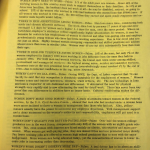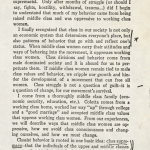Introduction
This section is a centralized source of information about a few of the major feminist frameworks during the post-war period – liberal, socialist/marxist, and radical feminism – with theory, definitions, and primary sources found in the Sallie Bingham Center for Women’s History and Culture.
Topics in this exhibit include:
- Background information on these theoretical feminist frameworks
- Examples found in the Sallie Bingham Center for Women’s History and Culture
- Applied examples on feminism and STEM work, feminism and knowledge production, and feminism and automation
On face value, theoretical feminist frameworks during the post-War era were not explicitly focused on technology and computer science. Yet this section aims to show that many feminist theories are (1) implicitly concerned with technology as they responded to changes to women’s employment, knowledge-production, and advertising practices and (2) versatile enough in their analysis to do techno-cultural analysis.
Three Common Feminist Frameworks
Liberal, socialist/marxist, and radical feminist theories have different perspectives on women’s empowerment, technology use, and advertising practices. This summary is not comprehensive. These frameworks overlap, inform each other, and are part of a greater narrative of liberation struggles and unique lived experiences. In this interview, media critic Jean Kilbourne spells out some of the tensions between liberal and radical feminism in her work, and former advertising executive Caroline Bien also speaks to the goals of liberal feminism.
Liberal feminism calls for legal, economic, and educational equality between women and men in the “public sphere,” focusing on incremental reforms rather than drastic change. Liberal feminism locates women’s oppression on the level of individual choice and action, and focuses on overcoming sexism using reason, socialization, and policy.
Socialist and Marxist feminism views women’s oppression through the connected framework of capitalism and patriarchy, centering class analysis and economic inequality. Marxist feminism, in particular, emphasizes material and historical context, including systems of race.
Radical feminism locates the source of women’s oppression in omnipresent patriarchal gender relations rather than legal, political, or educational systems. Radical feminists sought to challenge the naturalization of the gender binary and heterosexuality that traps women in care work, sexual subservience, and the “private sphere.”
Examples in the Sallie Bingham Centers
Gallery 1 shows some examples of primary sources using different feminist frameworks found in the Sallie Bingham Center. The first is an example of how Liberal feminists used reason, evidence, and personal action to fight sexism. The second is an example of how Socialist and Marxist feminists focused on building class consciousness. The third document is an example of how Radical feminists saw the patriarchy as the most fundamental and early form of oppression.
Gallery 1
- Liberal: ALFA Archives, Box 12
"Myths about Working Women" by Joy F. Sokeitous and Kahy McFadden (ALFA Archives, Box 12, Unknown date, most likely early 1970's.)
- Socialist: ALFA Archives, Box 13
- Radical: ALFA Archives, Box 12
Examples of feminism and technology
Feminism and STEM Work
Liberal feminists aimed for more women to enter the labor force. They pushed women to get into STEM education and jobs by increasing women’s confidence in their mathematical skills or by having standardized testing rephrased to help women’s comprehension, as suggested in this 1972 feminist theory paper.

ALFA Archives, Box 13.
On the other hand, radical and socialist feminists were more likely to be suspicious of the integrity of STEM professions themselves, pointing out they how they are also products of oppressive systems of patriarchy and capitalism. Marxist feminists questioned whether women should even want to get more involved in yet another patriarchal space: the labor market. “All work in this society is alienating,” according to the 1970 Marxist zine below, singling out “computer programmers and skilled machinists” for being especially devoid of leisure and play.
- ALFA Archives, Box 13
"Woman and her mind: the story of daily life" by Meredith Tax. 1970. Boston. ALFA Archives. Box 13. Folder 13.1
- ALFA Archives, Box 13
Feminism and Knowledge Production
One key part of the technological change in the advertising industry was the information revolution. Advertising firms not only gained more information about its consumers, but new forms of information.
Part of the computer’s appeal to advertising corporations was technology’s apparently superior knowledge – that is, the belief that information produced by computers was more rational, objective, and unbiased than human sources. The privileging of the computer’s rational empiricism over the human’s irrational subjectivity mirrors gender relations in which men are considered to be more rational than woman, a trope used by advertisements and by company executives alike. Feminists confronted these ideas about “knowledge” and “subjectivity” in different ways. Liberal feminists sought to prove that women were just as rational as men, but Marxist feminists believed that if the underlying assumptions about knowledge and rationality were made explicit, then women’s oppression would clearly be central to these systems of knowledge-production.
- ALFA Archives, Box 13
Second Sex Conference Notes. ALFA Archives. Box 13.
- ALFA Archives, Box 13
Second Sex Conference Notes. ALFA Archives. Box 13.
Even if advertisers respected the knowledge produced by women about other women, it was often used to sell harmful or useless products to other women, as Dr. Kilbourne noted in this interview. Computers that allowed more fully-fleshed out information to be collected and easily available were probably used in the same way, as this case study into data processing in marketing shows. Whereas lack of information about women may have been a problem, so too was invasion of privacy. Furthermore, the tension between “rational” knowledge and “subjective” knowledge was gendered within advertising firms; all-male research departments had Metrics, and more-female and diverse creative departments had their gut feelings, as Caroline Bien points out in this interview.
Feminism and Automation
The archival material used for this exhibit never explicitly mentions office automation, but we might still wonder how a technological development like computational automation in the workplace might have been perceived by different feminists.
Socialist feminists might have emphasized the impact that automation and computerization of office work would have on female office workers who were employed doing those tasks (such as the automation of clipping articles by AMI). Would it make women’s jobs easier so they could do other things, or would they lose their entire job? While automation promised more leisure time for women – perhaps a goal for Marxist feminists – this leisure time was most likely unemployment – a major obstacle for liberal feminists. Furthermore, the comparison and replacement between automated machines and obedient secretaries in advertisements feminized technology into another patriarchal relationship, as radical feminists might have pointed out. After all, automation is never truly fully automatic; any suggestion otherwise further hides the labor of women working these “automated machines,” once again having no product with market-value to show for it.
Conclusion
The goal of this section is that by fleshing out feminism’s pre-existing focuses on technology and the advertising industry, it will become easier to apply feminist thinking in other techno-cultural contexts. This section also seeks to make clear that multiplicity in feminist thought is necessary in order to adequately tackle something as complex as the intersection of technology and advertising in women’s lives.







